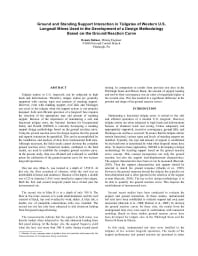Mining Publication: Ground and Standing Support Interaction in Tailgates of Western U.S.Longwall Mines Used in the Development of a Design Methodology Based on the Ground Reaction Curve
Original creation date: July 2010
Authors: DR Dolinar
NIOSHTIC2 Number: 20037619
Proceedings of the 29th International Conference on Ground Control in Mining, Morgantown, West Virginia, July 27-29, 2010. Barczak T, ed., Morgantown, WV: West Virginia University, 2010; :152-160
Tailgate entries in U.S. longwalls can be subjected to high loads and deformations. Therefore, tailgate entries are generally supported with varying types and amounts of standing support. However, even with standing support, roof falls and blockages can occur in the tailgate when the support system is not properly designed. Safe and efficient operation of a longwall face requires the selection of the appropriate type and amount of standing support. Because of the importance of maintaining a safe and functional tailgate entry, the National Institute for Occupational Safety and Health (NIOSH) is currently developing a standing support design methodology based on the ground reaction curve. Using the ground reaction curve for design requires that the ground and support interaction be quantified. This can be accomplished by the installation and analysis of data from instrumented field sites. Although necessary, the field results cannot develop the complete ground reaction curve. Numerical models, calibrated to the field results, are used to establish the complete ground reaction curve. In the present study, data was obtained and evaluated to establish points for calibration of the ground reaction curve for two western longwall operations. One test site, Mine A, was located at a depth of 1,550 ft. At this site, the floor consisted of siltstone, while the roof was an interbedded siltstone and sandstone. Because of the depth, a double row of 22-in diameter CANs were installed to support the tailgate. Both the first and second longwall panels have mined past the instrumented site. The second site in Mine B is at a depth of only 760 ft. The floor at this mine consists of a weak shale/mudstone and the roof consists of thick, top coal overlain by weak shales. At this site, a double row of pumpable cementitious cribs was installed. The second test site has only been subjected to side abutment loading from first panel longwall mining. The measurements indicate that the support at both mines was heavily loaded when subjected to the side abutment loading from first panel mining. At the deeper site, the support began to yield when the face was more than 300 ft outby during second panel mining. In comparison to results from previous test sites in the Pittsburgh Seam and Illinois Basin, the amount of support loading and roof-to-floor convergence was an order of magnitude higher at the western sites. This has resulted in a significant difference in the position and shape of the ground reaction curves.

NIOSHTIC2 Number: 20037619
Proceedings of the 29th International Conference on Ground Control in Mining, Morgantown, West Virginia, July 27-29, 2010. Barczak T, ed., Morgantown, WV: West Virginia University, 2010; :152-160